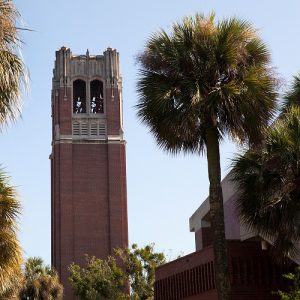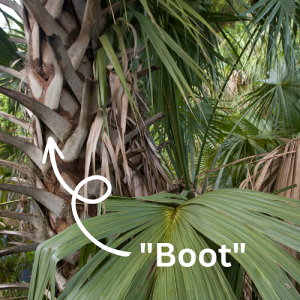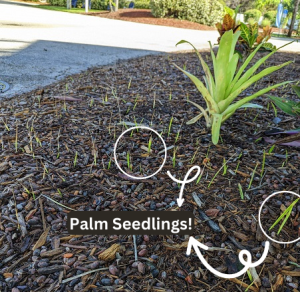The Palm Tree: A Florida Icon
Palm trees can be found in every corner of the Sunshine State, as they are a great landscape plant, are easy to maintain, and are hardy when planted in the right environment. There are over 30 types of palms that thrive in Florida, some growing best in the southern most portion of the state, but there is a species that will prosper wherever you are located. The native Sabal Palm is known to host other plant and animal species in its “boots”, which is the base of a cut frond, and the fibers found within these boots provide nesting material for birds of all kinds.
Most palm trees will flower and produce fruit once per year, and depending on the species, this fruit may be edible! Coconut and date palms are a couple examples of palms that can be grown for food production in your own yard. Bees and wasps love the flowers of palm trees, and local wildlife feed on the fruit produced. However, when wildlife is not present, this fruit can become a nuisance for maintained landscapes.
Palm Seedlings: A Preventable Problem
When the fruit of palm trees falls and is not removed, hundreds of little palm seedlings may begin popping up all over nearby landscape beds. If there is a fleshy layer to the fruit, it will start to decompose wherever it falls – which may not smell the greatest. With a little preemptive planning, this problem is completely preventable.
Mechanical Removal
Prior to flowering, palms will produce a seed pod that contains the flower buds which will eventually produce fruit. During routine palm maintenance, these seed pods can be removed, which will eliminate any possibility of a palm seedling invasion. If the seeds have already rooted and are starting to grow, the best option of removal is hand pulling. If the soil is amply wet, the seedlings should pull right out. A dandelion removal tool can also be used to make removal easier.
 Chemical Removal
Chemical Removal
If the fruits have already fallen from the tree, and hand pulling is not an option for you, the use of a preemergent herbicide can prevent the seedlings from sprouting. The herbicide should contain trifluralin or oryzalin to be effective. Remember that preemergent herbicides will only work BEFORE the seedling starts growing! To kill seedlings that are already growing, use an herbicide that works on woody plants, with active ingredients such as triclopyr or picloram. Roundup (i.e., glyphosate) will NOT be effective on palm seedlings. Be sure to read any herbicide label in its entirety prior to applying the product. It’s the law! For questions, contact your local Extension office.
Note: All images are the property of UF/IFAS.
HELP PROVIDE BLOG IMPACTS BY COMPLETING THIS SURVEY (bit.ly/47a26UN)
THANK YOU!
 5
5



